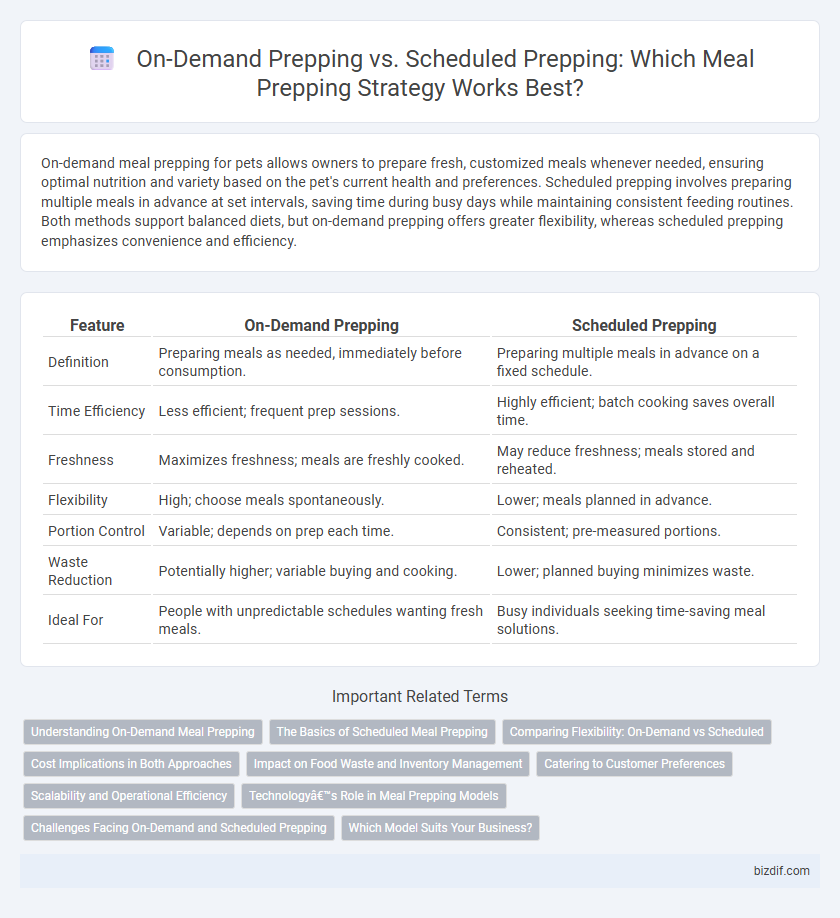On-demand meal prepping for pets allows owners to prepare fresh, customized meals whenever needed, ensuring optimal nutrition and variety based on the pet's current health and preferences. Scheduled prepping involves preparing multiple meals in advance at set intervals, saving time during busy days while maintaining consistent feeding routines. Both methods support balanced diets, but on-demand prepping offers greater flexibility, whereas scheduled prepping emphasizes convenience and efficiency.
Table of Comparison
| Feature | On-Demand Prepping | Scheduled Prepping |
|---|---|---|
| Definition | Preparing meals as needed, immediately before consumption. | Preparing multiple meals in advance on a fixed schedule. |
| Time Efficiency | Less efficient; frequent prep sessions. | Highly efficient; batch cooking saves overall time. |
| Freshness | Maximizes freshness; meals are freshly cooked. | May reduce freshness; meals stored and reheated. |
| Flexibility | High; choose meals spontaneously. | Lower; meals planned in advance. |
| Portion Control | Variable; depends on prep each time. | Consistent; pre-measured portions. |
| Waste Reduction | Potentially higher; variable buying and cooking. | Lower; planned buying minimizes waste. |
| Ideal For | People with unpredictable schedules wanting fresh meals. | Busy individuals seeking time-saving meal solutions. |
Understanding On-Demand Meal Prepping
On-demand meal prepping involves preparing meals as needed, offering flexibility and reducing food waste by tailoring portions to immediate consumption. Unlike scheduled prepping, which requires advanced planning and batch cooking, on-demand prepping adapts to daily changes in appetite and schedule. This approach is ideal for individuals seeking customized nutrition and minimal storage requirements.
The Basics of Scheduled Meal Prepping
Scheduled meal prepping involves planning and preparing meals at set times, ensuring consistent availability of healthy food throughout the week. This method optimizes grocery shopping, reduces mealtime stress, and supports dietary goals by aligning meal portions and ingredients with a fixed schedule. Key components include selecting recipes, batch cooking, and portioning meals in advance to streamline daily nutrition management.
Comparing Flexibility: On-Demand vs Scheduled
On-demand meal prepping offers unparalleled flexibility, allowing users to prepare meals as needed based on daily changes in schedule or appetite, which suits dynamic lifestyles and uncertain plans. Scheduled prepping requires allocating specific time slots, promoting routine and efficiency while ensuring consistent meal availability but offering less adaptability to spontaneous activities. Choosing between on-demand and scheduled prepping hinges on balancing the need for convenience with the desire for meal planning structure, impacting time management and dietary consistency.
Cost Implications in Both Approaches
On-demand meal prepping often incurs higher costs due to frequent ingredient purchases and potential food waste from spontaneous cooking decisions. Scheduled prepping allows bulk buying and better inventory management, reducing overall expenses by optimizing ingredient usage and minimizing spoilage. Both approaches impact budget planning differently, with scheduled prepping generally offering more predictable and lower food costs.
Impact on Food Waste and Inventory Management
On-demand prepping reduces food waste by allowing meal preparation based on immediate consumption needs, minimizing surplus and spoilage. Scheduled prepping improves inventory management by enabling bulk purchasing and organized storage, but risks higher waste if consumption patterns change unexpectedly. Balancing on-demand and scheduled prepping optimizes ingredient usage and maintains fresher inventory levels.
Catering to Customer Preferences
On-demand meal prepping allows customers to customize their orders with flexible timing, catering to individual schedules and spontaneous cravings. Scheduled prepping offers consistency and convenience by providing pre-planned meals at regular intervals, ideal for those seeking routine and balanced nutrition. Both approaches enhance customer satisfaction by addressing diverse lifestyle needs and eating habits.
Scalability and Operational Efficiency
On-demand meal prepping offers greater scalability by allowing kitchens to adjust production based on real-time demand, reducing waste and optimizing resource allocation. Scheduled prepping enhances operational efficiency through batch cooking and streamlined workflows that minimize labor costs and improve inventory management. Combining both approaches can balance flexibility with consistency, maximizing overall productivity in foodservice operations.
Technology’s Role in Meal Prepping Models
Technology significantly enhances on-demand meal prepping by enabling users to customize orders instantly through apps and AI-driven platforms, ensuring fresh ingredients tailored to immediate needs. Scheduled prepping leverages automation and smart kitchen appliances that streamline batch cooking and ingredient inventory management ahead of time. Integrating IoT devices and cloud-based meal planning tools optimizes both models by improving efficiency, reducing food waste, and aligning prep with personal lifestyle rhythms.
Challenges Facing On-Demand and Scheduled Prepping
On-demand prepping often struggles with inconsistent ingredient availability and time constraints, leading to rushed meals and higher waste. Scheduled prepping faces challenges in maintaining freshness and adapting to changing dietary preferences or unexpected schedule shifts. Both methods require strategic planning to optimize nutrition, minimize waste, and ensure meal variety throughout the week.
Which Model Suits Your Business?
On-demand meal prepping offers flexibility and reduces food waste by preparing meals based on real-time orders, making it ideal for businesses with fluctuating customer demand. Scheduled prepping enables consistent batch cooking, optimizing ingredient purchase and labor costs, which suits businesses with predictable order volumes. Evaluating your customer patterns and operational capacity is crucial to determine which model enhances efficiency and profitability.
On-demand prepping vs scheduled prepping Infographic

 bizdif.com
bizdif.com